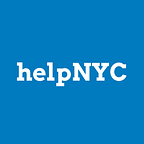Homelessness during COVID-19: State of the City
By Tahreem Nawaz for helpNYC
Despite already having the nation’s largest homeless population, New York City has reached the highest levels of homelessness since the Great Depression in the 1930’s due to the COVID Crisis. The number of homeless single adults is 109% higher than it was ten years ago.
In May 2021, there were 51,882 homeless people, including 15,930 homeless children, sleeping each night in the New York City municipal shelter system. That does not include the thousands of others sleeping on the streets, in the subway system, or in other public places. Out of a population of 8.3 million, nearly every 1 in 106 New Yorkers is homeless. Multiple factors contribute to the increasing homelessness, but the primary cause among families is a lack of affordable housing. Other notable causes are eviction, doubled-up or severely overcrowded housing, domestic violence, job loss, and hazardous housing conditions.
The COVID-19 pandemic has dramatically intensified the crisis. Before the pandemic, an estimated 1 in 5 New Yorkers was already living in poverty, and since the start of the pandemic, 1 in 7 New Yorkers have lost their jobs and tens of thousands are at risk of eviction. Many New Yorkers are already on the brink of homelessness and the pandemic has pushed many past their limit.. To make matters worse, people facing homelessness remain more susceptible to contracting and dying from COVID-19. The virus-related death rate for homeless New Yorkers living in shelters is 49% higher than the citywide average.
Moreover, homelessness has many long-term negative consequences. Recent data from the New York State Education Department shows homeless students graduated at a 16% lower rate than non-homeless students during the 2019–2020 school year. And homelessness is inextricably linked to race and mental health. As a result of deliberately racist housing, land use, and property rights policies, people of color have always experienced disproportionate housing insecurity and homelessness.
Black and Hispanic/Latinx New Yorkers suffer more than their White counterparts. . Approximately 57 percent of heads of households in shelters are Black, 32 percent are Hispanic/Latinx, and 7 percent are White. In terms of mental health, studies show that the large majority of unsheltered homeless New Yorkers are people living with mental illness or other severe health problems. A Coalition for the Homeless report found that two-thirds of the city’s street homeless population have mental health needs.
Tahreem Nawaz is a volunteer Communication Associate for helpNYC. She currently is a second year student at Boston University.
